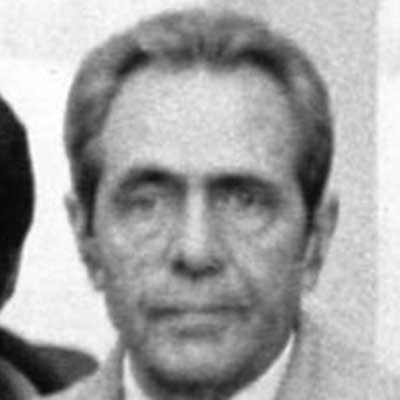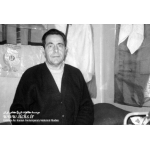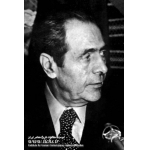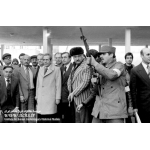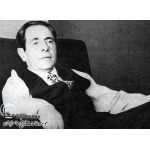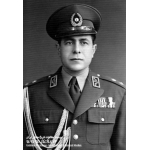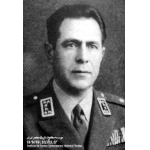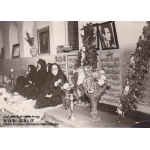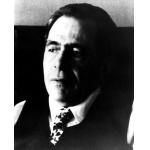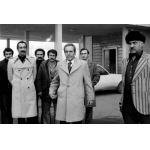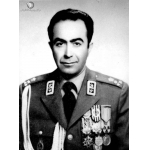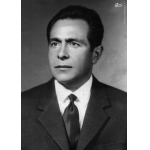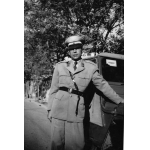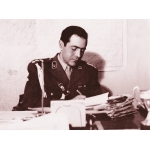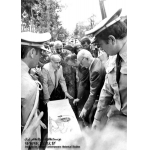Gharani, Mohammad Vali
Masoumeh Sajaadiyan
477 بازدید
Mohammad Vali Gharani (1929–1979) was a member of the Islamic Revolution Council and the first Chief of Staff of the Iranian Army after the victory of the Islamic Revolution in Iran. He was assassinated and martyred by the Forqan group.
Gharani was born in 1929 in Tehran. His father was a telecommunications manager. After spending several years in Shiraz, as they were returning to Tehran, his father fell ill and passed away in Abadeh. The family, under the care of his mother, stayed in Isfahan for a year. Gharani began his secondary education at Dar ul-Fonoon High School and completed it at the Military High School (Army High School). In 1930, he entered the Army Officer School (Military Academy) and graduated in 1932 with the rank of Second Lieutenant in the artillery branch.[1] He completed his studies at the University of War and passed the intelligence course with distinction.[2] He held various positions such as Acting Commander of the 2nd Regiment Battalion, 4th Artillery Regiment, Commander of the 105th Battalion, Head of the 3rd Staff Department of the Logistics Training Center, Commander of the Artillery Park of the 2nd Division, Head of the 3rd Staff Department of the 2nd Division, Inspector of the 2nd Central Division, Chief of Staff of the 2nd Division, Deputy Director of the Army's General Supply Department, Commander of the Independent Rasht Brigade, Head of the 2nd Staff Department of the Army, and Second Deputy Chief of Staff. In October 1957, he was promoted to the rank of Major General.[3]
Gharani attempted to organize a group of military elites to stage a coup against the monarchy of Mohammad Reza Pahlavi.[4] For this crime, he was arrested on February 27, 1958. According to Articles 330 and 343 of the Pahlavi Army’s Code of Criminal Procedure, he was charged with interference in civilian affairs, disobedience, participation in political activities, and failing to report to the Shah. On June 11, 1958, he was sentenced to two years in prison by a military court. After an appeal, on July 22, 1958, his sentence was extended to three years in prison, and he was expelled from the Imperial Army.[5]
On November 29, 1960, after serving two years and eight months of his sentence, Gharani was pardoned and released. He had meetings with members of the National Resistance Movement and the National Front, including Mehdi Bazargan, Allahyar Saleh, Ayatollah Seyyed Reza Zanjani, Karim Sanjabi, and Ayatollah Seyyed Mahmoud Taleghani. He also established relations with Ayatollah Seyyed Mohammad Hadi Milani, who was connected with many leaders of the National Resistance Movement.
From 1962, Gharani resumed his activities against the Pahlavi regime. As a result, he was arrested again on December 26, 1963.[6] He spent nine months in solitary confinement at the Qezel Qal'eh Prison, without visitation rights. He was later sentenced to three years in prison by a military court on charges of treason against national security. He remained imprisoned until December 11, 1966. After his release, he remained under SAVAK surveillance until the final days of the Pahlavi monarchy,[7] but Gharani continued to maintain connections with Engineer Bazargan and other opposition leaders. Due to the lack of employment and income, he endured financial hardship.[8]
In December 1978, on the eve of the Islamic Revolution's victory, Gharani became a member of the Revolutionary Council. He remained a member of this council until February 12, 1979, when he was appointed by Imam Khomeini as the Chief of Staff of the Army. Gharani held this position for 43 days.[9]
The Prime Minister of the interim government, Mehdi Bazargan, consulted with Gharani regarding military appointments after the revolution’s victory.[10] Additionally, Imam Khomeini tasked him with the responsibility of purging the army of loyalists to the previous regime.[11]
On the evening of March 18, 1979, anti-revolutionary groups attacked the 28th Infantry Division’s barracks in Sanandaj, killing 21 people. Simultaneously, they occupied the headquarters of the 28th Division located at the Officers' Club and took Colonel Mashallah Safari, Commander of the 28th Kurdistan Division, hostage. They forced him to send a message over the radio and television, instructing the forces inside the barracks to cease resistance and surrender to the attackers.
Gharani contacted the division’s deputy commander, Colonel Mohammad Sultan Ishaq, by phone, relaying Imam Khomeini's order to defend the barracks and issuing firm instructions to resist and suppress the attackers. He also dispatched two hundred army commandos to Sanandaj. With permission from Imam Khomeini, Gharani ordered a sonic boom to be created in order to instill fear in the hearts of the anti-revolutionaries. Valiollah Fallahi also entered Sanandaj on Gharani’s orders to take command of the forces. After eleven days of battle, the barracks were freed from siege.[12]
On March 26, 1979, due to what he saw as interference by unauthorized individuals in military matters, Gharani submitted a letter of resignation to Imam Khomeini, stepping down from his role as Chief of Staff of the Army.[13] On April 23, 1979, Gharani was martyred at his home by Hamid Niknam, a member of the terrorist group, Forqan, at 11:30 a.m.[14] The day after his martyrdom, Imam Khomeini expressed his sorrow in a public statement.[15] Gharani's body was buried near the shrine of Hazrat Masoumeh in Qom.[16] A street in Tehran, formerly known as Ardeshir Zahedi Street, was renamed after Martyr General Gharani. After his martyrdom, he was posthumously awarded the rank of General.[17]
[1] Norouzi Farsangi, Ahmad, Untold Stories from the Life of Lieutenant General Qarani, Tehran: Zohd Publishing Cultural Institute, 2003, p. 45.
[2] Encyclopedia of the Islamic Revolution for Teenagers and Young People, Vol. 3, Tehran: Soure Mehr, 2015, p. 123.
[3] Norouzi Farsangi, Ahmad, Untold Stories from the Life of Lieutenant General Qarani, p. 494.
[4] Ramin, Ali, Fani, Kamran, Sadat, Mohammad Ali, Daneshgostar Encyclopedia, Tehran: Daneshgostar Rooz Institute, 2010, p. 328.
[5] Norouzi Farsangi, Ahmad, Untold Stories from the Life of Lieutenant General Qarani, pp. 73, 74 and 494.
[6] Ibid., p. 74; Encyclopedia of the Islamic Revolution for Teenagers and Young People, vol. 3, p. 123.
[7] Norouzi Farsangi, Ahmad, Untold Stories from the Life of Lieutenant General Qarani, pp. 92, 441, 448, 459, and 473
[8] Encyclopedia of the Islamic Revolution for Teenagers and Young People, vol. 3, p. 124.
[9] Ibid., p. 124; Nowrouzi Farsangi, Ahmad, Untold Stories from the Life of Lieutenant General Qarani, pp. 199 and 200.
[10] Norouzi Farsangi, Ahmad, Untold Stories from the Life of Lieutenant General Qarani, p. 74.
[11] Ibid., p. 113.
[12] Ibid., pp. 192, 286, and 256-251; Shahed Yaran, Vol. 82, August 2012, p. 17.
[13] Encyclopedia of the Islamic Revolution for Teenagers and Young People, Vol. 3, p. 124; Shahed Yaran, Vol. 82, p. 7.
[14] Nowrozi Farsangi, Ahmad, Untold Stories from the Life of Lieutenant General Qarani, pp. 330, 331, and 327; Encyclopedia of the Islamic Revolution for Teenagers and Young People, Vol. 3, p. 124.
[15] Shahed Yaran, Vol. 82, p. 2.
[16] Encyclopedia of the Islamic Revolution for Teenagers and Young People, Vol. 3, p. 124.
[17] Shahed Yaran, Vol. 82, p. 90.


